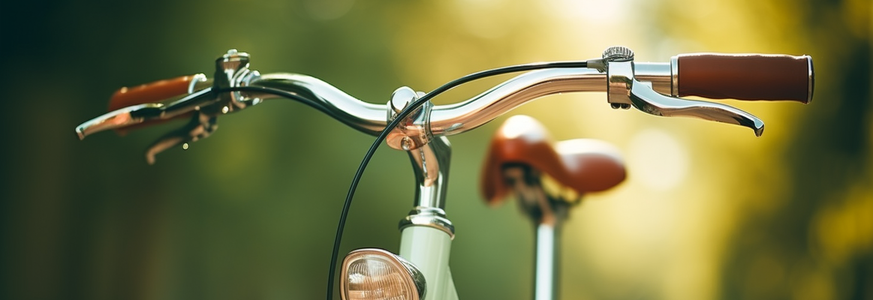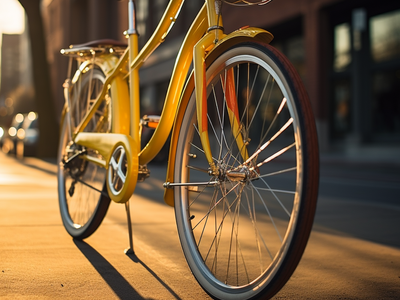Bicycle mudguards: everything you need to know
When it comes to cycling, the saying 'prevention is better than cure' holds true. While cycling can be an enjoyable and healthy activity, it also exposes riders to various environmental influences that can affect their experience.
One such influence is water, which can cause discomfort and possible damage to both the cyclist and their bike. This is where bicycle mudguards and fenders come into play.
Mudguards are essential additions to any bike and provide protection from splashing water, dirt and debris that can occur during rides. They act as a shield between the wheels and the rider, preventing water from splashing onto the cyclist's body or face. They also help keep the bike cleaner longer by reducing the amount of dirt and debris that accumulates on the components.
This article will introduce different types of mudguards and fenders available on the market today, walk readers through the installation process, discuss the benefits associated with their use, provide tips on maintenance and care, and offer insights on choosing the right mudguard or fender for specific bikes.
By thoroughly understanding these aspects, cyclists can enhance their riding experience while ensuring optimal protection from unwanted splashes.
Types of fenders and mudguards
 The various types of bicycle fenders offer cyclists a practical and aesthetically pleasing solution to protect themselves and their bikes from water, mud and dirt while riding.
The various types of bicycle fenders offer cyclists a practical and aesthetically pleasing solution to protect themselves and their bikes from water, mud and dirt while riding.
These accessories are available in a variety of materials, each of which has its own advantages and disadvantages. The most common materials used to make fenders are plastic, aluminum alloy, stainless steel, carbon fiber and wood.
Plastic fenders are lightweight, affordable and easy to install. They provide adequate protection from splashes from the road surface, but may not be as durable as those made from other materials.
Aluminum alloy fenders offer increased durability compared to plastic fenders. They are resistant to rust and corrosion, but can add significant weight to the bike.
Stainless steel mudguards are extremely durable and rust resistant. They offer excellent protection from water mist, but can be heavier than other options.
Carbon fiber mudguards stand out for their lightweight properties, yet are strong enough to withstand impacts. However, they tend to be more expensive compared to other materials.
In terms of bicycle aerodynamics, the influence of mudguards and splash guards must be taken into account. Although these accessories create some drag due to their presence in the airflow around the bike, the effect is generally minimal for recreational cyclists or commuters at lower speeds. For competitive races or time trials where every second counts, choosing low-profile or minimalist fender designs could help reduce aerodynamic drag.
Overall, when selecting a type of bicycle fender or splash guard material for cyclists, it is important to consider factors such as durability requirements, weight impact on performance goals, aesthetic preferences, and potential impact on aerodynamics based on riding style or level of competition.
Installing mudguards and fenders on your bike.
To properly install fenders and mudguards on a bicycle, careful attention should be paid to the alignment and positioning of these important components. Proper mounting techniques for fenders will ensure that they effectively protect the rider from splashes and debris. Here are some important steps to consider when installing fenders and mudguards on your bike:
-
Choose the right type of fender: there are different types of fenders such as full fairing, clip-on or quick release fenders. Consider your riding style and terrain to choose the most appropriate one.
-
Alignthe fenders symmetrically: Make sure both front and rear fenders are symmetrically aligned with the center of the wheel for optimal coverage.
-
Set up sufficient clearances: make sure there is enough space between the tire and the fender to prevent encroachment while driving.
-
Securely attach brackets: use appropriate brackets or braces to securely attach the fender to your bike frame or fork.
-
Consider different materials: fenders can be made of plastic, aluminum alloy or carbon fiber. Each material has its own advantages and disadvantages in terms of weight, durability, flexibility and cost.
By following these proper installation techniques and considering different materials for your bike's fenders, you can ensure their effective performance in keeping you clean and dry during wet rides.
Advantages of using mudguard accessories
 You can appreciate the benefits of using add-on components to protect you from splashes and dirt, while improving the functionality and aesthetics of your bike.
You can appreciate the benefits of using add-on components to protect you from splashes and dirt, while improving the functionality and aesthetics of your bike.
One such accessory is the bike mudguard, which is used to maintain the cleanliness of the bike and prevent water damage.
The main advantage of using mudguards is their ability to keep the bike clean. When riding on wet or muddy terrain, these accessories act as a barrier between the wheels and the rider, preventing water and dirt from splashing onto the frame, chain and rider's clothing. This not only ensures a cleaner appearance, but also reduces the need for frequent cleaning and maintenance.
Additionally, mudguards play an important role in preventing water damage to various parts of the bike. Water can cause rust on metal components such as chains, gears and brakes. By providing protection from water splashes, these accessories help extend the life of these parts by minimizing exposure to moisture.
In addition, mudguards offer practical benefits by enhancing the overall riding experience. They ensure riders stay dry during rainy rides by deflecting water away from them. This not only improves comfort, but also reduces the risk of slipping on wet surfaces.
There are numerous benefits to integrating mudguards and accessories into bicycle equipment. These include keeping the bike clean by preventing splash damage and minimizing moisture exposure, which ultimately improves both functionality and aesthetics and provides a more enjoyable riding experience.
Mudguard and fender maintenance and care.
 Maintenance and care of mudguards and fenders includes regular cleaning and inspection to ensure proper functionality and longevity of these protective elements. To effectively maintain fenders and mudguards, the following cleaning tips should be followed:
Maintenance and care of mudguards and fenders includes regular cleaning and inspection to ensure proper functionality and longevity of these protective elements. To effectively maintain fenders and mudguards, the following cleaning tips should be followed:
-
Regular cleaning: It is important to clean mudguards and fenders after riding in wet or muddy conditions. Use a mild soap solution and a soft brush or cloth to gently remove dirt or debris from the surface. Rinse thoroughly with water to remove all soap residue.
-
Inspect for damage: Regularly inspect fenders and mudguards for signs of damage such as cracks, dents or loose fasteners. Fixing these problems in a timely manner will prevent further damage to the components.
-
Fix common problems: If water accumulates between the fender/mudguard and the tire and rubs or makes noise while riding, adjusting the position of the fender can solve this problem. In addition, if there is excessive rattling or movement while riding, check that all fasteners are tight.
By following these maintenance practices, cyclists can ensure that their fenders and mudguards remain functional and long-lasting. Regular cleaning prevents dirt buildup that could affect performance, while thorough inspections identify problems that need immediate attention. Fixing common problems allows riders to address small concerns before they develop into larger complications.
Selecting the straightening fender and mudguard for your bike
 Selecting an appropriate fender and mudguard for a bicycle is critical to ensuring optimal protection from splashes, debris and water spray.
Selecting an appropriate fender and mudguard for a bicycle is critical to ensuring optimal protection from splashes, debris and water spray.
For example, a cyclist who frequently rides on dirt roads may benefit from a fender with larger coverage to prevent mud and debris from being thrown onto the rider's back.
When selecting fenders and mudguards, it is important to consider both material and size.
Mudguard and fender materials can vary, with common options including plastic, aluminum alloy and carbon fiber. Plastic fenders are lightweight and affordable, but may not be as durable as other materials. Aluminum alloy fenders offer a good balance of weight and strength, making them suitable for a variety of riding conditions. Carbon fiber fenders offer an excellent strength-to-weight ratio, but tend to be more expensive.
In terms of size, it is important to choose mudguards that are compatible with the tire size of your bike. Mudguards that are too narrow may not provide enough protection, while mudguards that are too wide may compromise the tires or frame of the bike. It is recommended that you measure the tire width or consult the manufacturer's specifications for the correct size before purchasing mudguards.
By considering both the materials used and the correct size when selecting mudguards and fenders for your bike, you can ensure optimal protection from splashes while maintaining compatibility with your bike configuration.
More articles that might interest you
,format(png)/advert/ad-OER-fahrradwerkzeuge-wartungszubehoer.png)
,format(png)/advert/ad-PYP-Der-ultimative-Guide-fuer-Fahrrad-Trinkflaschen.png)
,format(png)/advert/ad-UTS-fahrradtraeger-bequemes-radfahren.png)
,format(png)/advert/ad-rEB-Der-ultimative-Ratgeber-fuer-Fahrradsaettel-und-Sattelstuetzen.png)
,format(png)/advert/ad-J7y-fahrradtasche-sicher-praktisch.png)
,format(png)/advert/ad-LdD-fahrrad-handyhalterung-zubehoer.png)
,no_upscale(),format(png)/prod/5/3/8/imp_1_538218.jpg)
,no_upscale(),format(png)/prod/5/4/4/imp_1_544299.jpg)
,no_upscale(),format(png)/prod/5/2/6/imp_1_526877.jpg)
,no_upscale(),format(png)/prod/4/4/4/bimg_444914_446728-2023-07-21_16-58-38-1080p.jpg)
,no_upscale(),format(png)/prod/4/6/3/bimg_463994_478871-2023-07-11_14-55-28-1080p.jpg)
,no_upscale(),format(png)/prod/5/3/8/imp_1_538217.jpg)
,format(png)/advert/ad-5iU-die-ultimative-anleitung-fahrradreifenwartung.png)
,format(png)/advert/ad-4Cw-fahrradcomputer-gps-zubehoer.png)
,format(png)/advert/ad-wj0-fahrrad-kassettenwechsel.png)
,format(png)/advert/ad-3Z4-fahrradklingel.png)
,format(png)/advert/ad-P09-fahrradhelmzubehoer-sicherheit.png)
,format(png)/advert/ad-cXP-fahrradanhaenger-zubehoer-komfort-sicherheit.png)
,no_upscale(),format(png)/prod/4/9/3/imp_1_493997.jpg)
,no_upscale(),format(png)/prod/5/3/8/imp_1_538219.jpg)
,no_upscale(),format(png)/prod/4/9/3/imp_1_493996.jpg)
,no_upscale(),format(png)/prod/5/2/1/imp_1_521657.jpg)
,no_upscale(),format(png)/prod/5/2/1/imp_1_521656.jpg)
,no_upscale(),format(png)/prod/5/4/4/imp_1_544289.jpg)
,no_upscale(),format(png)/prod/5/4/4/imp_1_544323.jpg)
,no_upscale(),format(png)/prod/5/4/4/imp_1_544292.jpg)
,no_upscale(),format(png)/prod/5/4/4/imp_1_544307.jpg)